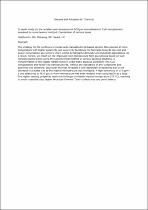 ResearchSpace
ResearchSpace
In depth study on the notable room-temperature NO2gas sensorbased on CuO nanoplatelets prepared by sonochemical method: Comparison of various bases
JavaScript is disabled for your browser. Some features of this site may not work without it.
- ResearchSpace
- →
- Research Publications/Outputs
- →
- Journal Articles
- →
- View Item
| dc.contributor.author |
Oosthuizen, Dina N

|
|
| dc.contributor.author |
Motaung, David E

|
|
| dc.contributor.author |
Swart, HC

|
|
| dc.date.accessioned | 2019-03-29T06:45:39Z | |
| dc.date.available | 2019-03-29T06:45:39Z | |
| dc.date.issued | 2019-08 | |
| dc.identifier.citation | Oosthuizen, D.N., Motaung, D.E. and Swart, H.C. 2019. In depth study on the notable room-temperature NO2gas sensorbased on CuO nanoplatelets prepared by sonochemical method: Comparison of various bases. Sensors and Actuators B: Chemical, v. 266, pp 761-772. | en_US |
| dc.identifier.uri | https://www.sciencedirect.com/science/article/pii/S092540051830604X | |
| dc.identifier.uri | http://hdl.handle.net/10204/10876 | |
| dc.description | Copyright: 2018. Elsevier. Due to copyright restrictions, the attached PDF file only contains the abstract of the full text item. For access to the full text item, kindly consult the publisher's website. | en_US |
| dc.description.abstract | The strategy for the synthesis of metal oxide nanostructured based sensors that operate at room temperature with higher sensitivity and selectivity facilitates the forecasts towards low cost and power consumption gas sensors which will be beneficial to domestic and industrial applications. As a result, herein, we report on the improved room temperature NO2 gas sensing based on CuO nanostructures grown using the sonochemical method in various aqueous solutions. A transformation of the copper nitrate solution under basic aqueous conditions into CuO nanoplatelets and flower-like nanostructures, without the assistance of any surfactants and additives was observed. Structural analyses revealed a size–dependent broadening due to the decrease in platelet size as the reaction temperature was increased. A high sensitivity of 173 ppm-1 and selectivity to NO2 gas at room-temperature has been realized when using NaOH as a base. The higher sensing properties were due to longer synthesis reaction temperature (75 °C), resulting to small crystallite size, higher Brunauer-Emmett-Teller surface area and point defects. | en_US |
| dc.language.iso | en | en_US |
| dc.publisher | Elsevier | en_US |
| dc.relation.ispartofseries | Worklist;22053 | |
| dc.subject | CuO | en_US |
| dc.subject | Gas sensors | en_US |
| dc.subject | Nanoflowers | en_US |
| dc.subject | Nanoplatelets | en_US |
| dc.subject | Sonochemical | en_US |
| dc.title | In depth study on the notable room-temperature NO2gas sensorbased on CuO nanoplatelets prepared by sonochemical method: Comparison of various bases | en_US |
| dc.type | Article | en_US |
| dc.identifier.apacitation | Oosthuizen, D. N., Motaung, D. E., & Swart, H. (2019). In depth study on the notable room-temperature NO2gas sensorbased on CuO nanoplatelets prepared by sonochemical method: Comparison of various bases. http://hdl.handle.net/10204/10876 | en_ZA |
| dc.identifier.chicagocitation | Oosthuizen, Dina N, David E Motaung, and HC Swart "In depth study on the notable room-temperature NO2gas sensorbased on CuO nanoplatelets prepared by sonochemical method: Comparison of various bases." (2019) http://hdl.handle.net/10204/10876 | en_ZA |
| dc.identifier.vancouvercitation | Oosthuizen DN, Motaung DE, Swart H. In depth study on the notable room-temperature NO2gas sensorbased on CuO nanoplatelets prepared by sonochemical method: Comparison of various bases. 2019; http://hdl.handle.net/10204/10876. | en_ZA |
| dc.identifier.ris | TY - Article AU - Oosthuizen, Dina N AU - Motaung, David E AU - Swart, HC AB - The strategy for the synthesis of metal oxide nanostructured based sensors that operate at room temperature with higher sensitivity and selectivity facilitates the forecasts towards low cost and power consumption gas sensors which will be beneficial to domestic and industrial applications. As a result, herein, we report on the improved room temperature NO2 gas sensing based on CuO nanostructures grown using the sonochemical method in various aqueous solutions. A transformation of the copper nitrate solution under basic aqueous conditions into CuO nanoplatelets and flower-like nanostructures, without the assistance of any surfactants and additives was observed. Structural analyses revealed a size–dependent broadening due to the decrease in platelet size as the reaction temperature was increased. A high sensitivity of 173 ppm-1 and selectivity to NO2 gas at room-temperature has been realized when using NaOH as a base. The higher sensing properties were due to longer synthesis reaction temperature (75 °C), resulting to small crystallite size, higher Brunauer-Emmett-Teller surface area and point defects. DA - 2019-08 DB - ResearchSpace DP - CSIR KW - CuO KW - Gas sensors KW - Nanoflowers KW - Nanoplatelets KW - Sonochemical LK - https://researchspace.csir.co.za PY - 2019 T1 - In depth study on the notable room-temperature NO2gas sensorbased on CuO nanoplatelets prepared by sonochemical method: Comparison of various bases TI - In depth study on the notable room-temperature NO2gas sensorbased on CuO nanoplatelets prepared by sonochemical method: Comparison of various bases UR - http://hdl.handle.net/10204/10876 ER - | en_ZA |





